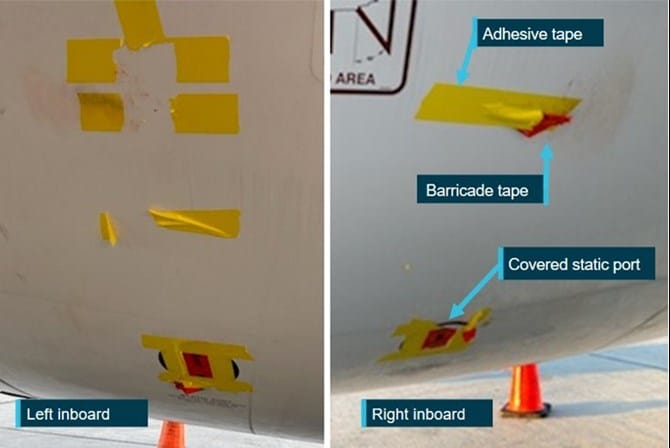Aerospace
Boeing 787 took off from Melbourne to Los Angeles with tape covering its engine cowl fan static ports

- Boeing 787 being used for freight operations flew from Melbourne to Los Angeles with tape covering its engine cowl fan static ports;
- While the flight was uneventful, the covered ports meant redundancy for the engine electronic control system was reduced;
- Job instruction card for restoring a 787 to service did not link to Boeing’s recommended procedures;
- Qantas has amended its engineering instructions to properly reference Boeing’s recommended procedures.
According to a new ATSB investigative report, a Boeing 787 freight plane flew from Melbourne to Los Angeles with tape covering four of its static ports.
A Qantas engineer discovered tape covering the four static ports on the aircraft’s engine fan cowls after the Qantas 787-9 aircraft, registered VH-ZNJ, landed in Los Angeles on the morning of September 22, 2021.
Aircraft systems rely on static ports for critical air pressure data. When the aircraft is parked for up to 7 days, Boeing suggests covering them to prevent contamination, and Qantas has included this recommendation into its ‘regular’ parking practise.
“Later that day, another engineer was tasked to conduct the ‘restore’ procedure to return the aircraft to flight status,” ATSB Director Transport Safety Stuart Macleod explained.
“The tape on the engine fan cowls was not removed by that engineer, as per the manufacturer’s procedures, and this wasn’t identified by flight crew or dispatch during pre-departure checks.”
VH-ZNJ subsequently took off with the tape still on its engine fan cowl static ports.
“While the flight was uneventful, the covered ports meant redundancy for the engine electronic control system was reduced,” Mr Macleod noted.
The ATSB found that while the job instruction card (JIC) developed by Qantas for parking a 787 did link to Boeing’s recommended procedures, the JIC for restoring it back to service did not.
“This was a missed opportunity to assist engineers to readily access the current procedures and determine which ports were covered, and also allowed for different interpretations of which ports could be covered,” Mr Macleod said.
Mr Macleod continued, “The second officer also believed Qantas engineers had performed a pre-flight examination prior to the flight crew arriving at the aircraft.”
Following the incident, Qantas sent letters to engineering, flight and ramp crews, pointing out the location of the fan cowl static ports and warning that they may be covered.
More details click

Aerospace
Boeing Transfers Rocket Stage to NASA, Paving Way for Human Moon Mission

Boeing has achieved a significant milestone by providing NASA with the second core stage of the Space Launch System (SLS) rocket.
This crucial component, crafted at NASA’s Michoud Assembly Facility (MAF), is set to propel the Artemis II crew into lunar orbit, marking humanity’s return to deep space after a 50-year hiatus.
The monumental Boeing-built rocket stage, the largest element of the Artemis II mission, will embark on a journey aboard the Pegasus barge, traveling 900 miles to NASA’s Kennedy Space Center.
Comparison of two legendary aircraft B777x vs B747 aircraft:Click here
Upon arrival, it will be meticulously integrated with other essential Artemis II components, including the upper stage, solid rocket boosters, and NASA’s Orion spacecraft within the iconic Vehicle Assembly Building. This intricate integration process is a vital step toward the eagerly anticipated Artemis II launch, slated for 2025.
“Boeing-built products helped land humankind on the moon in 1969, and we’re proud to continue that legacy through the Artemis generation,” remarked Dave Dutcher, vice president and program manager for Boeing’s SLS program. “Together, with NASA and our industry partners and suppliers, we are building the world’s most capable rocket and paving the way to deep space through America’s rocket factory in New Orleans.”
NASA, Lockheed Martin Reveal X-59 Quiet Supersonic Aircraft:Click here
The delivery of Core Stage 2 marks a significant achievement in the evolution of the SLS rocket. Towering over 200 feet and powered by four RS-25 engines, this core stage, coupled with two solid-fueled booster rockets, will generate a staggering 8.8 million pounds of thrust. This immense power is crucial to launching Artemis II and future missions into the vast expanse of space.
The SLS rocket stands unparalleled in its capability to transport both crew and substantial cargo to the moon and beyond in a single launch. Its extraordinary capacity will facilitate the delivery of human-rated spacecraft, habitats, and scientific missions to destinations including the moon and Mars, ushering in a new era of space exploration.
-

 Travel1 week ago
Travel1 week agoAir India to Expand US Operations with Three New Routes After a Decade
-

 Travel2 weeks ago
Travel2 weeks agoWhy We Should Avoid These Stamps in a Passport
-

 Airlines1 month ago
Airlines1 month agoInvestigations Reveal Fake Chinese Titanium in Boeing and Airbus Jets
-

 Tech4 weeks ago
Tech4 weeks agoChina’s CATL Plans 1,800-Mile Electric Plane Launch by 2027
-

 Airport3 days ago
Airport3 days agoTop 10 Largest Airports in the World by Size
-

 Aerospace4 weeks ago
Aerospace4 weeks agoChina’s Fighter Jets Turn Wings into Autonomous Drones
-

 Airlines4 days ago
Airlines4 days agoAir India Rolls Out A350s for Delhi-New York JFK and Newark Routes
-

 Defence3 weeks ago
Defence3 weeks agoBoeing Enhances Chinook with New Engines and Block II Upgrades at $96 Million







